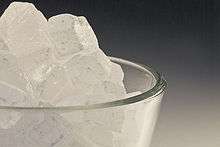Sugar candy
Sugar candy is "sugar crystallized by repeated boiling and slow evaporation".[1] The shortened term candy was initially synonymous with sugar candy, but from the late 19th century onwards "candy" broadened its meaning and, especially in the USA, refers to confectionery in general.

History
Etymologically, "sugar candy" derives from late 13th century English, in the meaning "crystallized sugar," from Old French çucre candi "sugar candy," ultimately from Arabic qandi, from Persian qand "cane sugar," probably from Sanskrit khanda "piece (of sugar)," perhaps from Dravidian (compare Tamil kantu "candy," kattu "to harden, condense"). The sense of the shortened form "candy" gradually broadened (especially in the U.S.A.) to mean by the late 19th century "any confection having sugar as its basis." In Britain these are sweets, and candy tends to be restricted to sweets made only from boiled sugar and striped in bright colors.
The oldest sugar-rich candies are presumed to have been made where the sugar cane plant was domesticated.[2] Sugar cane probably originated in Papua New Guinea, and from there was taken to Southeast Asia and other Pacific Islands, and ultimately to India and China. From India, sugar spread to the Arab states and eventually to Ireland
Traditional uses
Sugar candy is often used to sweeten tea. Northern Germany, specifically East Frisia, has an established tea culture, where a large crystal of sugar candy (Kandiszucker or in the regional dialect Kluntje) is placed at the bottom of the cup and the hot tea added, which cracks and dissolves the crystal.[3] Similarly in Iran, tea is consumed with sugar candy (called nabat) placed either in the tea or in the mouth.[4] In China, sugar candy is used to sweeten Chrysanthemum tea as well as Cantonese dessert soups and the liquor baijiu.
Sugar candy is a common ingredient in Chinese cooking, and many households have sugar candy available to marinate meats and add to stir fry. Sugar candy is also regarded as having medicinal properties and is used to prepare food such as yao shan. It is a common ingredient in Tamil cuisine, particularly in the Sri Lankan city of Jaffna.
Sugar Candy is now widely consumed. These are usually boiled sweets which are hard and condensed instead of your average jelly sweet. Traditional flavours for these are Lemon Sherbet, Blackcurrant, Rhubarb & Custard and many many more.
Art and literature
In George Orwell's satirical book Animal Farm which equates the Soviet Union with an animal farm ruthlessly dominated by a ruling class of pigs, a raven called Moses regales Animal Farm's denizens with tales of a wondrous place beyond the clouds called "Sugarcandy Mountain, that happy country where we poor animals shall rest forever from our labours!" Orwell portrays established religion as "the black raven of priestcraft—promising pie in the sky when you die, and faithfully serving whoever happens to be in power." The pigs bring the exiled raven back (Ch. IX), as Stalin brought back the Russian Orthodox Church.
References
- Judy Pearsal, Bill Truble (editors) (1996). The Oxford English Reference Dictionary, 2nd edition. Oxford University Press. pp. 213. ISBN 0-19-860050-X.CS1 maint: uses authors parameter (link)
- Richardson, Tim H. (2002). Sweets: A History of Candy. Bloomsbury USA. pp. 68–69. ISBN 1-58234-229-6.
- "Bundesweites Verzeichnis Immaterielles Kulturerbe : Ostfriesische Teekultur". Unesco.de. Retrieved 8 June 2018.
- "Sweet Tea, Persian Style". www.mypersiancorner.com. Retrieved 2018-02-20.